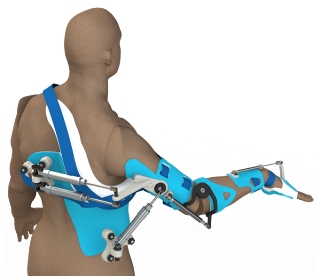Dec 9 2014
New research in robotics might help with stroke rehabilitation, guide wheelchairs, and assist children with Autism Spectrum Disorder. Projects investigating co-robotics are the focus of new funding from the National Institutes of Health.
 Conceptual eMbot design featuring three cylinders spanning the shoulder and a single cylinder spanning the elbow and wrist. Credit: Richard Brent Gillespie, University of Michigan, Ann Arbor
Conceptual eMbot design featuring three cylinders spanning the shoulder and a single cylinder spanning the elbow and wrist. Credit: Richard Brent Gillespie, University of Michigan, Ann Arbor
This is the third year NIH has participated in the Interagency National Robotics Initiative (NRI) to support research to develop innovative co-robots—robots that work cooperatively with people. Other participants are the National Science Foundation, the National Aeronautics and Space Administration, and the U.S. Department of Agriculture. Funding for these projects totals approximately $2.3 million over the next five years, subject to the availability of funds.
“Technology is becoming more and more adaptable in all areas of our life, from GPS in cars to speech recognition technology on smart phones,” said Grace Peng, Ph.D., program director of Rehabilitation Engineering at the National Institute of Biomedical Imaging and Bioengineering (NIBIB). “With these awards, we hope to encourage robotics researchers to think of new ways to apply their technology in the realm of health care.
Wearable exoskeletons to induce recovery of function
Recovering limb movement after a stroke can be difficult and frustrating for patients. Research suggests that repeatedly using the affected arm in goal-directed, purposeful movements after a stroke can help promote recovery. This kind of movement is most successful when supervised by therapists. This project hopes to extend therapy into the home by providing patients with a lightweight robotic exoskeleton that can be placed on an affected arm and provide the kind of therapeutic guidance found at a rehabilitation center.
Richard Brent Gillespie, Ph.D., University of Michigan, Ann Arbor
Funded by NIBIB, EB019834
A computer vision-based active learning co-robot wheelchair
This project hopes to provide a solution for elderly and disabled patients who have limited hand functionality and who rely on wheelchairs for mobility. Researchers hope to create a system and chair that can be controlled by the user’s head movements and will adapt to the individual user. A camera placed on glasses worn by the user can capture head movements designed to control the chair as well as adapt to individual users by gaining information as the patient responds to various situations in natural ways (such as turning their head as their attention shifts). The hope is that the robotic wheelchair will be able to operate almost completely autonomously and only ask for human control on an as-needed basis—learning from the human controls so as to reduce the necessity for human participation in the future.
Gang Hua, Ph.D., Stevens Institute of Technology, Hoboken, New Jersey
Funded by the National Institute of Nursing Research, NR015371
Music-based interactive robotic orchestration for children with Autism Spectrum Disorder
Many new technologies for children with autism spectrum disorder (ASD) have been developed and demonstrated the possibilities of robotic applications in therapy, but most rely on speech interaction and task-based scenarios. To more effectively stimulate the various emotional and social interactivities of children with ASD, researchers need to take further steps to incorporate multiple types of stimuli. Recent studies have shown improvements in social skills among children with autism who were encouraged to improvise with musical instruments or song. This project aims to develop a music-based system that will help children with ASD interact with a robotic companion in a safe and natural manner. The results of this study have the potential to help develop innovative interventions for ASD.
Chung Hyuk Park, Ph.D., New York Institute of Technology, New York City
Funded by the Eunice Kennedy Shiver National Institute of Child Health and Development, HD082914